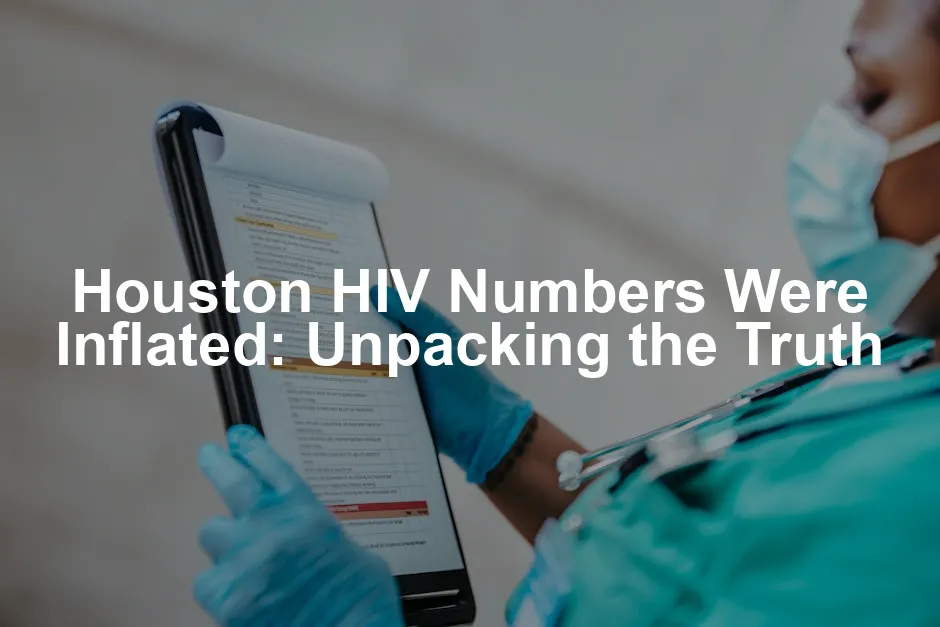Introduction
Claims have surfaced that HIV numbers in Houston were exaggerated. Accurate data is crucial for public health discussions. Let’s analyze these claims and reveal the true statistics behind HIV in Houston.
Summary and Overview
HIV’s history in Houston spans decades, with significant efforts to combat the virus. Over the years, local health departments have reported fluctuating rates of diagnoses. Recently, some public figures have claimed that the reported numbers are inflated. Understanding the real statistics is essential for effective public health policies and community interventions.
Disparities exist among different demographic groups. For instance, Black individuals represent a disproportionate share of new diagnoses. These disparities highlight the importance of accurate data. Misinterpretations may lead to misguided public perceptions and ineffective resource allocation.

Speaking of accurate data, if you want to dive deeper into the statistics that shape public health, consider adding HIV/AIDS: A Very Short Introduction to your reading list. It’s a great resource to understand the broader context of HIV and its impact across the globe.
The Context of HIV in Houston
Houston has seen a complex history with HIV. In 2018, approximately 27,000 people were living with HIV in the city. This figure reflects a growing concern since the number of living cases increased by 14% from 2012 to 2016. When compared to national averages, Houston’s rates remain notably higher.
Socio-economic factors significantly influence HIV rates in the community. Education levels, poverty, and healthcare access play pivotal roles. For instance, individuals in lower-income neighborhoods often face barriers to testing and treatment. This complexity underscores the need for tailored interventions that consider these socio-economic challenges. Addressing these factors can help reduce the overall HIV burden in Houston.

To aid in prevention, consider having a HIV Testing Kit at home. It provides peace of mind and can be a crucial step towards understanding your health status.
Claims of Inflated Numbers
Origins of the Claims
Recent claims about inflated HIV numbers in Houston have stirred controversy. Some public officials and community advocates have raised concerns over these statistics. Their assertions often arise in discussions about funding for health initiatives. For example, during budget proposals, politicians sometimes cite alarming figures to justify increased spending on HIV programs. This can create a perception that the HIV epidemic is worsening, prompting calls for more resources.
Political motivations play a significant role in these claims. When officials push for funding, they may exaggerate the statistics to highlight urgency. This tactic can sway public opinion and secure financial support for health initiatives. However, such claims can mislead the community. They may create fear rather than inform residents about the real situation. Understanding the reasons behind these statements is crucial. It highlights the need for scrutiny in public health discourse.

If you’re keen to explore the political side of health, check out The Politics of Public Health: A Critical Analysis. It’s a fascinating read that dives into how public health is influenced by policy and politics.
Analysis of Data Sources
The data sources referenced in these claims often come from local health departments and advocacy organizations. While these sources aim to provide accurate information, they can have biases. For instance, some organizations may present data selectively to emphasize particular narratives. This can skew public perception of the HIV situation in Houston.
Additionally, the methodology used to collect and report these statistics can vary. Differences in how data is gathered or defined can lead to discrepancies. For example, some reports might categorize cases differently, inflating figures unintentionally. This raises questions about data credibility.

When evaluating the HIV statistics controversy, it’s important to analyze the sources critically. Is the data peer-reviewed? Are multiple viewpoints represented? This evaluation helps ensure that the information shared with the public is accurate and reliable. Ultimately, transparency in data reporting is essential for building trust in public health initiatives.
The Impact of Misleading Information
Public Health Consequences
Misleading HIV statistics can have serious public health consequences. When numbers are inflated, it creates a distorted view of the epidemic. This misrepresentation may lead to misguided public health initiatives. For example, funding may be allocated based on exaggerated claims. This can divert resources from areas that genuinely need them.
Accurate data is vital for effective awareness campaigns. When statistics do not reflect reality, community trust erodes. People may feel misled or confused about the actual risk of HIV. This can hinder community members from seeking testing and treatment. Ultimately, this contributes to increased transmission rates.

Community organizations rely on accurate data to drive their efforts. Misleading information can disrupt outreach programs. Initiatives designed to educate and inform may lose credibility. If communities believe the statistics are exaggerated, they may dismiss important health messages. It’s crucial to foster an informed public that understands the true landscape of HIV in Houston.
Stigma and Discrimination
Misinformation perpetuates stigma surrounding HIV. When inflated statistics circulate, they reinforce negative stereotypes. This is particularly damaging to marginalized communities. Individuals may face discrimination based on their perceived risk level. This stigma can discourage people from getting tested or seeking treatment.
For many in these communities, the fear of judgment is real. They may worry about how their status could affect their relationships and livelihoods. This fear can lead to a cycle of silence and shame. When people don’t talk about HIV, it remains shrouded in stigma.

Addressing misinformation is essential to combat this stigma. Communities must work together to create an environment of understanding. Education is key to dispelling myths and fostering acceptance. By promoting accurate information, we can build trust and support within the community. Ultimately, this helps create a healthier, more informed society.
Addressing the Need for Accurate Data
Importance of Data Integrity
Accurate data is essential for shaping effective health policies. When health authorities rely on precise statistics, they can allocate resources wisely. This ensures that community outreach is targeted and impactful. Misleading data can lead to misguided initiatives, wasting valuable time and funding. For instance, if HIV numbers are inflated, communities may divert attention from areas genuinely in need. Real statistics empower stakeholders to make informed decisions. They foster trust between health officials and the public, encouraging proactive health behaviors. Ultimately, data integrity is the backbone of public health strategies.

For more insights on statistical learning and its implications, check out an introduction to statistical learning with python book length.
Additionally, if you’re looking for resources on how to collect and manage health data effectively, Health Data Management: Best Practices is a fantastic guide.
Strategies for Improvement
To ensure reliable data collection, several strategies can be implemented. First, standardizing data collection methods across organizations can enhance consistency. This includes using clear definitions for what constitutes a new diagnosis. Second, training personnel on accurate data reporting is crucial. Engaging community members in this process can promote transparency. When locals understand how data is collected, they are more likely to trust the information. Third, establishing an independent oversight committee can help verify data accuracy. Regular audits and public reporting of findings can further enhance accountability. Encouraging open communication about data can lead to community engagement. When people feel involved, they may advocate for better health resources. These steps together can significantly improve data integrity, ultimately benefiting public health initiatives.

Conclusion
In summary, the claims of inflated HIV numbers in Houston highlight the importance of accurate data. Reliable statistics are vital for effective public health strategies and resource allocation. They not only inform policy but also build community trust. As we navigate these issues, we must prioritize transparency and vigilance in public health reporting. Together, we can ensure that our communities receive the support they truly need.
FAQs
Why are there claims that Houston’s HIV numbers were inflated?
Claims about inflated HIV numbers stem from political discussions and budget proposals. Some officials argue that alarming statistics justify increased funding for health initiatives. This context can lead to misinterpretation of data, causing fear rather than informing the public. Understanding these motivations is essential to clarify the ongoing HIV situation in Houston.
What are the actual statistics regarding HIV in Houston?
As of 2018, approximately 27,057 people lived with HIV in Houston. That year, there were 1,243 new diagnoses. The number of individuals living with HIV increased by 14% from 2012 to 2016. Despite fluctuations, rates in Houston remain higher than both Texas and national averages, necessitating accurate data for effective public health strategies.
How does misinformation about HIV statistics affect public health?
Misinformation can lead to misguided public health initiatives. When statistics are exaggerated, resources may be misallocated. This can erode community trust and discourage people from seeking testing or treatment. Ultimately, it can contribute to higher transmission rates and worsen public health outcomes.
What demographic groups are most affected by HIV in Houston?
The HIV epidemic disproportionately affects Black individuals in Houston. While they comprise about 22% of the population, they account for nearly 48% of HIV cases. This disparity highlights the need for targeted interventions in marginalized communities facing socio-economic challenges.
What steps can be taken to improve data accuracy in HIV reporting?
Standardizing data collection methods across organizations can enhance reliability. Training staff on accurate reporting is crucial. Community engagement in data collection fosters transparency and trust. Additionally, establishing independent oversight can help verify data accuracy, ensuring the community has access to reliable information.
How can communities combat stigma related to HIV?
Communities can launch educational campaigns to promote understanding and acceptance. Initiatives that involve local leaders and organizations help to destigmatize HIV. Encouraging open conversations about HIV within community settings can also break down barriers and promote testing and treatment.
Where can I find more information on HIV resources in Houston?
For more information, check local health organizations such as the Houston Health Department and Allies in Hope. These organizations provide resources for testing, treatment, and education regarding HIV in the community. You can also visit the Texas Department of State Health Services website for comprehensive information on HIV programs and services.
For those interested in self-care and wellness while navigating these serious topics, consider exploring a Health and Wellness Journal. It’s a great way to reflect and track your journey towards better health.
Please let us know what you think about our content by leaving a comment down below!
Thank you for reading till here 🙂
All images from Pexels




